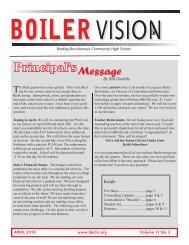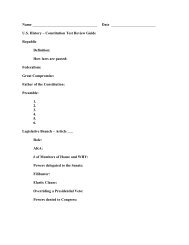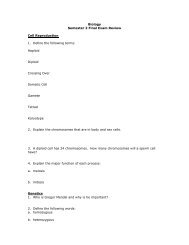Pickleball - Bradley-Bourbonnais Community High School
Pickleball - Bradley-Bourbonnais Community High School
Pickleball - Bradley-Bourbonnais Community High School
Create successful ePaper yourself
Turn your PDF publications into a flip-book with our unique Google optimized e-Paper software.
<strong>Pickleball</strong><br />
Activity Description<br />
The mini-tennis game called <strong>Pickleball</strong> was created during the summer of 1965 on Bainbridge Island, WA.<br />
<strong>Pickleball</strong> got its name from the family dog. Pickles was the family dog that would chase after the errant<br />
balls and then hide in the bushes. The game was later shortened to the namesake of Pickle-ball. <strong>Pickleball</strong><br />
has grown and expanded from a family activity game to a paddle court sport with formalized rules.<br />
Now, over 20 years later Pickle-ball is played in thousands of school P.E. programs, parks and recreation<br />
centers, correctional facilities, camps, YMCA's and retirement communities.<br />
The strategy of the game is in ball placement not on strength or size of the player. The winner of the<br />
game is the player/team that first reaches 11 points. A player/team must win by 2 points.<br />
Equipment<br />
Whiffleballs the size of a baseball or softball are used. The smaller the ball the faster the speed of the<br />
game. The paddle used in pickleball is made of hardwood or plywood. A cord is attached to the butt of the<br />
paddle and the wrist should be inserted through the cord to ensure the paddle does not come off.<br />
The Court<br />
The court dimensions are identical to a doubles badminton court.<br />
The net is hung 3 feet high on each end of the net and<br />
sags a little in the middle. A pickleball court has a non-volley zone<br />
7 feet deep on each side of the net.<br />
Objectives<br />
1. Demonstrate and apply game knowledge or rules and scoring.<br />
2. Students will demonstrate proper body weight transfer when performing swings and hit the bird<br />
consistently into the playing area.<br />
3. Coordinate game movements with a partner.<br />
Rules and Strategies<br />
1. Players must keep one foot behind the back line when serving. (straddle the serving line)<br />
2. The serve is made underhand. The paddle must pass below the waist.<br />
3. The serve is made diagonally cross-court and must clear the non-volley zone.<br />
4. Only one serve attempt is allowed, except in the event of a let (the ball touches the net on the<br />
serve, and lands on the proper service court). Then, the serve may be taken over.<br />
5. At the start of each new game, the 1st serving team is allowed only one fault before giving up the<br />
ball to the opponents. Thereafter, both members of each team will serve and fault before the ball is<br />
turned over to the opposing team.<br />
6. You can only score points when you are serving.<br />
7. Partners only switch sides of the court when they have scored a point.<br />
8. When the receiving team wins the serve, the player in the right hand court will always start play.<br />
9. When serving in singles, each player serves from the right hand court when their<br />
score is 0 or an even number, and from the left when their score is an odd number.
10. At the start of the serve, both members of the serving team should be back by the<br />
baseline, with the receivers split - one back to receive the serve and their partner<br />
up by the non-volley line to play the net.<br />
11. Only the receiver who is diagonally across from the server may return the serve or<br />
it is a fault.<br />
Game Play<br />
1. A game is played to eleven points and a team must win by two points.<br />
2. A ball landing on the line is in bounds.<br />
3. If a ball hits the net during play and goes over, it is in play.<br />
4. Each team must play their first shot off the bounce – Double Bounce Rule. That is, the first<br />
receiving team must let the served ball bounce, and the serving team must let the return of serve<br />
bounce before playing it.<br />
5. After the two bounces have occurred, the ball can be either volleyed or played off the bounce.<br />
6. To volley a ball means to hit it in the air without first letting it bounce.<br />
7. All volleying must be done with the player’s feet behind the non-volley zone line.<br />
8. Faults:<br />
Hitting the ball out of bounds<br />
Not clearing the net with the ball<br />
Stepping into the non-volley zone and volleying the ball<br />
Touching the net with your body, clothes or racquet while ball is in play<br />
Vocabulary<br />
Backhand – stroke hit on non racquet side of the body<br />
Baseline – end line of the pickleball court<br />
Drive – low shot that is hit near the opponent’s backcourt<br />
Drop shot – ground stroke hit in such a way that the ball drops just over the net into the non-volley<br />
zone<br />
Fault – serve which lands out of bounds or court area<br />
Foot fault – failure on the server’s part to keep at least one foot behind the baseline during the<br />
serve<br />
Forehand – shot hit on the racquet side of the body<br />
Let serve – serve that touches the top of the net and falls in the proper service court<br />
Lob – ball hit very high to pass over the reach of an opponent that falls within the court<br />
Non-volley zone – front area on either side of the net in which a player may not step into to volley a<br />
ball (hit in air without bounce).<br />
Smash – shot hit forcefully in downward motion from above the player’s head<br />
Volley – to hit the ball in the air before it bounces on the court






![New Student Course Guide[2] - Bradley-Bourbonnais Community ...](https://img.yumpu.com/47451319/1/190x245/new-student-course-guide2-bradley-bourbonnais-community-.jpg?quality=85)









